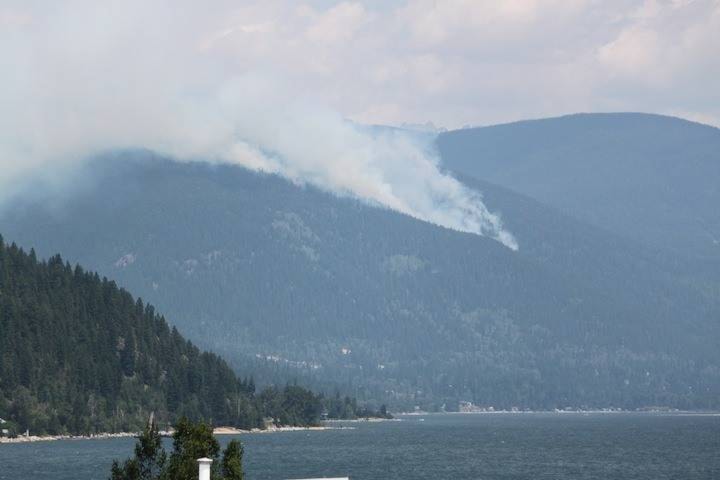Second in a series of articles about how municipal and regional governments are preparing for the possibility of a wildfire on Nelson’s doorstep. Part one was Nelson to set up emergency management centre published online on Sept 13.
What is being done to protect Nelson from a wildfire? What is being done to reduce the danger on all that forest land, loaded with dry fuel, just outside the city limits? These are familiar questions in Nelson these days.
But the answers are complicated because much of the forest is privately owned, part of West Arm Park or is Crown land licensed to timber companies.
So the city can’t simply decide to bulldoze a fire break around the perimeter of Nelson, as several online commenters on the Star website have insisted it do.
One of the components of wildfire protection is fuel treatment. That means modifying forest vegetation by retaining large dominant trees but thinning from below by removing small trees, then pruning the retained trees from the ground up to increase the height to the crown before removing all wood debris on the ground. The result: a forest of large trees with no underbrush, small trees, or debris.
Many players and owners
Because there are many players and owners, that work takes a lot of consultation and planning. And it’s expensive: it can cost up to $10,000 per hectare (although sometimes that cost can be lowered by cutting and selling the timber on the treated land). Everyone agrees there has not been enough funding, province-wide, and therefore the work has proceeded slowly.
But there has been a big increase over the past couple of years, because of stepped up funding from the province and the Union of B.C. Municipalities.
Consequently, the 900 hectares that are underway now in the RDCK, most of it in the planning stages, is almost twice the amount that has been done over the past decade, according to forest consultant John Cathro.
Province announces new funding
Add to that our upcoming share of a new $50 million invested over three years across the province just announced last week by the Horgan government. The new wildfire mitigation program replaces one that provided a small amount by comparison: $81 million over 14 years.
Related:
• Nelson to set up emergency management centre
• Nelson area wildfire protection plan presented
You can’t get money to treat the forest if you don’t have a Community Wildfire Protection Plan (CWPP). Nelson has one, and it is attached below. Some other areas of the RDCK have them, while others are as yet incomplete. The completed ones can be found on the RDCK website.
The rural areas adjacent to Nelson (Areas E and F) both have CWPPs.
The fuel mitigation work in the rural Nelson area is being co-ordinated by the RDCK in partnership with the city and BC Parks, as well as the timber licencees Kalesnikoff Lumber, BC Timber Sales and Cooper Creek Cedar.
First identify dangerous areas, then write prescriptions
The first step is to identify the specific forest areas that are the most dangerous. Those are identified on maps in the CWPPs. Much of it is on land licensed to timber companies.
Then the RDCK has to apply for funding to hire a forest consultant to write prescriptions for those priority areas. In other words, write down exactly what needs to be done, on the ground. Then, if the forest is on land licensed to a timber company, they have to negotiate with the company the type of work to be done and how it will be paid for.
Once the prescriptions are written, the RDCK has to apply for funding again to put workers out in the forest to do the work.
That process, from identifying priority areas to putting workers in the bush, including two rounds of funding applications, can take up to two years.
The fuel treatment work that’s being done now
Here is a summary of the work underway now, based on information given to the Star by Cathro, who is contracted to do much of the work:
• The RDCK is about to start writing prescriptions for 900 hectares of specific areas identified in CWPPs as urgent, at Glacier Regional Park, Smallwood, Howser, Redfish, Sproule Creek, Harrop Proctor, Woodbury, Kaslo, Johnstone Road, Glade, and Kokanee Provincial Park.
• B.C. Parks has completed writing prescriptions for about 450 hectares of work in West Arm Park. The work on the ground is expected to begin this fall. A wildfire in the park could endanger Nelson’s drinking water source at Five Mile Creek.
• Prescriptions are currently being written for 200 hectares at Selous Creek (a secondary water source for Nelson) and 150 hectares at Queens Bay. These will be done this winter and then funding applications will have to be submitted for the implementation work on the ground.
• According to Stephan Martineau, manager of the Slocan Integral Forest Cooperative, the organization has treated close to 600 hectares of land in the Slocan Valley in the last 10 years and has plans for another 1,000 hectares over the next five years. According to its forest manager Erik Leslie, the Harrop Procter Community Forest has done about 150 hectares of fuel treatments with 250 hectares planned.
Related:
• Action by Nelson area landowners key to wildfire safety, expert says
• RDCK plans wildfire fuel action
• West Arm Park wildfire prevention plans move forward
bill.metcalfe@nelsonstar.com
Like us on Facebook and follow us on Twitter
Nelson Community Wildfire Protection Plan by BillMetcalfe on Scribd
